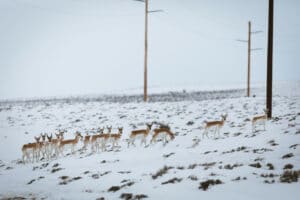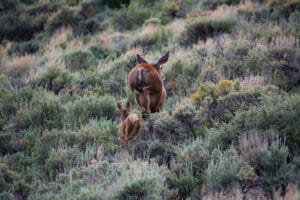The Wyoming Wildlife Federation makes decisions, creates campaigns, and forms initiatives based on the best available wildlife and habitat science. Our aim is to advocate for ecologically and economically sustainable management policies that benefit the wildlife, wildlands, and the people of Wyoming. By implementing science-based policy to the management of these natural resources, we see a future for Wyoming that includes healthy wildlife populations, connected habitat, and an economy that is economically sustainable.
Key Science-Based Management Issues:
CHRONIC WASTING DISEASE (CWD)
Chronic wasting disease (CWD) has been a chronic worry for Wyoming’s mule herds, causing slow wasting and death in any infected animals for 35 known years. During the early years of managing this disease, Wyoming chose a cautious wait-and-see approach. Given the unknowns about CWD at the time, that was as reasonable a decision as any. The research on the disease both in Wyoming, in neighboring Colorado, and states like Wisconsin, has since shown us that CWD has negative effects on deer populations at infection rates above 10%.
Recent sampling data shows many of Wyoming’s herd units are at these upper levels of CWD prevalence and are poised for population-leveling impacts. For game managers, this means that the wait-and-see approach is no longer an option to maintain healthy mule deer populations. Wyoming Wildlife Federation, as well as other partners in conservation, are working to get the word out and help the Wyoming Game and Fish Department (WGFD) move the needle on managing this disease. Many believe we (as a state) waited longer than we should have to take action in reducing CWD prevalence, but it’s not too late to do right by our herds using the framework of the Wyoming CWD Management Plan, adopted by WGFD in the summer of 2020.
GREATER-SAGE GROUSE MANAGEMENT
The Federation has long been involved with greater-sage grouse management. WWF helps the proactive, science-driven, locally-led conservation methods employed by the SGIT to yield the most economical and sustainable outcomes that will support Wyoming’s wildlife, economy, and way of life into the future.
Each fall, many of WWF’s members and staff take part in the conservative hunting seasons, which are an important tool to monitor sage grouse population health. Hunters voluntarily submit sage-grouse wings, allowing Wyoming Game and Fish Department (WGFD) biologists to estimate chick production/recruitment from the ratio of the number of chicks per hen. Greater sage-grouse population data is reported by WGFD in an annual Job Completion Report thanks to the hunter participation.
MIGRATION CORRIDORS
Through years of telemetry studies, scientists have mapped major migration corridors – especially for mule deer and antelope populations in Wyoming. The Red Desert to Hoback Migration is the longest known ungulate migration in the lower-48. The migration routes of ungulates across Wyoming are part of our natural heritage. They are part of what makes our state so wealthy in wild ungulates. Conserving these corridors while reducing and eliminating barriers to migration ensures that we will have healthy herds for the coming years and the next generation.
ELK FEEDGROUNDS
Elk feedgrounds have a long history in Wyoming. They serve to stabilize elk populations and prevent conflict with local ranchers. These are important and admirable goals but, like a person who continues to use a crutch instead of doing the hard work of physical therapy, feedgrounds are a system that allows us to sidestep some of the harder questions about habitat and sustainability, like how we protect and enhance existing winter habitat. Additionally, the presence of brucellosis and the recent detection of chronic wasting disease in these elk herds have created major concerns for wildlife populations and livestock producers.
While a complex issue, the Federation is dedicated to tackling the long-term solution to elk feedgrounds. The goal is to achieve a positive outcome for wildlife, livestock producers, hunters, and the economy of western Wyoming.
STATE MANAGEMENT OF GRIZZLY BEARS
Adopted in 2016, the Wyoming Grizzly Bear Management Plan outlines a comprehensive path forward to ensure the Greater Yellowstone Area District Population Segment of grizzly bears is maintained at or above current demographic recovery guidelines. The bears were removed from the ESA in 2017. In early 2018, the Wyoming Game and Fish Department assumed management of grizzly bears and proposed a conservative hunt within the guidelines of the Wyoming Grizzly Bear management plan that the Federation fully supported. The recovery of grizzly bears to the point where a hunting season was considered in 2018 was a major success story.
Later in September of 2018, a federal judge reinstated the bears on the Endangered Species List and put grizzly bears under federal management again. The judge ruled U.S. Fish and Wildlife Service officials were “arbitrary and capricious” in their 2017 decision to remove the bears’ protections under the Endangered Species Act.
Wyoming Wildlife Federation supports the state management of grizzly bears. WWF supports the careful structure in the plan to avoid exceeding take, and feels like not having grizzly bears in the GYE under state management undermines the intent of the Endangered Species Act. The combination of biology and social science is challenging, but critical to the long-term success of the ESA and similar programs for other species in the future.
Latest Related News
How to Submit an Effective Comment to the BLM
Learn what makes a comment that is helpful to making changes with the BLM.
Wyoming State Land Parcel 194: Why is it so Important?
Wyoming State Land Parcel 194: Why is it so important for wildlife?
Why “Fat Bottom Does” Make The Mule Deer World Go ‘Round
Fat mule deer equal healthier fawns, more survival, and bigger bucks. Find out how you can help ensure our does are healthy!
What We Do To Help
Wyoming Wildlife Federation has a number of specific Programs that address this
issue directly. Click on a Program in the list below to explore it in depth.
Help Protect Our Way of Life
We need everyone who values the wild spaces of Wyoming to get involved. Are you ready?




